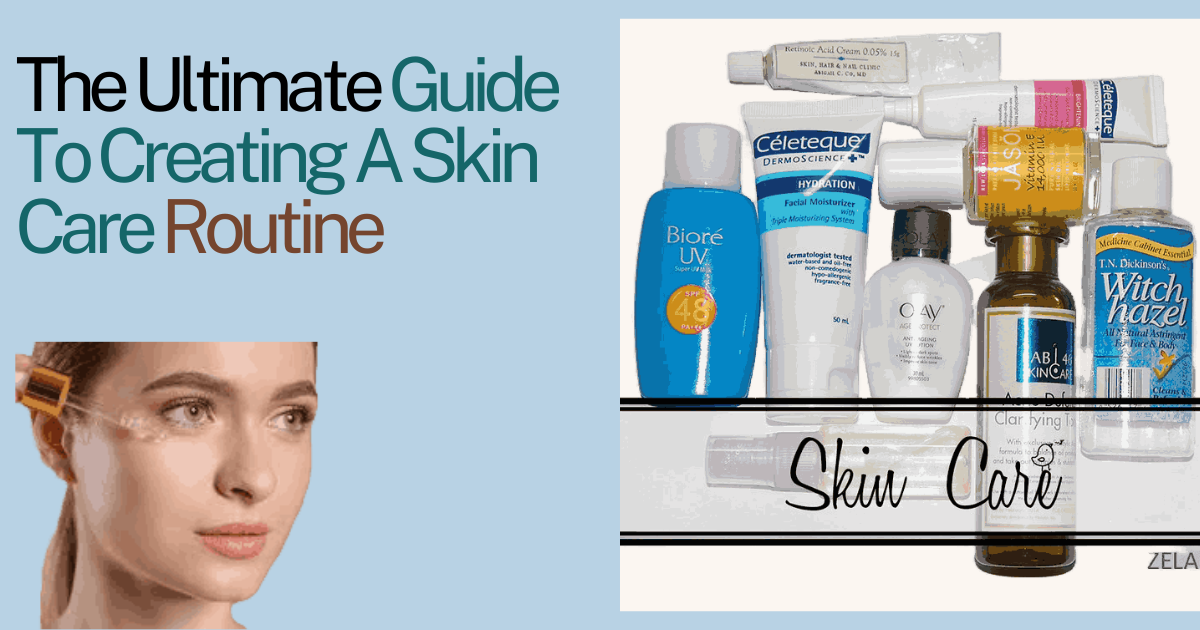The Ultimate Guide to Creating a Skin Care Routine
The skin, the body’s largest organ, acts as a protective barrier against environmental factors, regulates temperature, and enables sensory perception. It consists of three primary layers: epidermis, dermis, and subcutaneous tissue. The epidermis, the outermost layer, contains cells that produce melanin, which gives the skin its color and protects it from UV radiation. The dermis contains blood vessels, hair follicles, sweat glands and collagen, which provide structural support. Skin tissue consists of fat and connective tissue, aiding in insulation and cushioning.( Skin Care Routine)
Proper skin care is essential to maintaining skin health and preventing problems like dryness, acne, and premature aging. Key steps include cleansing, moisturizing, and sun protection. Cleansing removes dirt, oil and impurities, preventing clogged pores and breakouts. Moisturizing keeps the skin hydrated, preserving its elasticity and barrier function. Sunscreen protects against harmful UV rays, reducing the risk of skin cancer and premature aging.( Skin Care Routine)
Additionally, a balanced diet rich in vitamins and antioxidants supports skin health. Staying hydrated, getting enough sleep, and not smoking and drinking too much alcohol also contribute to a healthy complexion. Tailoring skin care routines to individual skin types and concerns, and consulting dermatologists when necessary, ensures optimal skin care.( Skin Care Routine) read more
Understanding Your Skin Type- Skin Care Routine
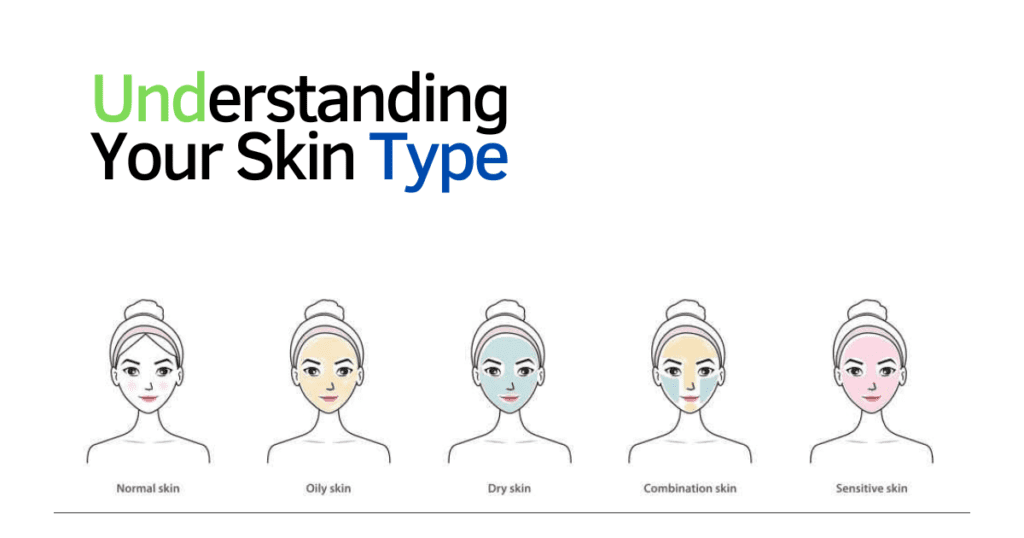
Before diving into the specifics of skin care products and routines, it’s important to understand your skin type. Accurately identifying your skin type allows you to choose the most effective products and develop a skincare routine ( Skin Care Routine)
that addresses your skin’s unique needs. Skin types generally fall into five categories: normal, dry, oily, combination, and sensitive. Let’s dig deeper into each type:
Normal Skin
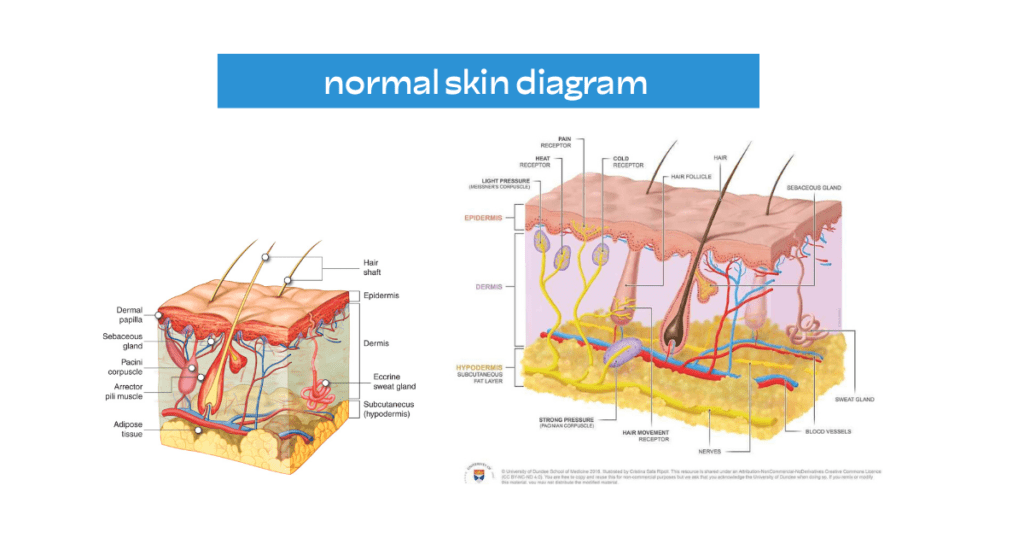
Characteristics:
- Balanced, neither too oily nor too dry
Smooth texture with minimal imperfections
Small, barely visible pores
Healthy complexion with few breakouts
Care Tips:
Normal skin is generally low maintenance, but maintaining its balance is important. Use a gentle cleanser,( Skin Care Routine)
light moisturizer and sunscreen daily. Regular exfoliation helps keep the skin clear and glowing without over-drying it.
Dry Skin
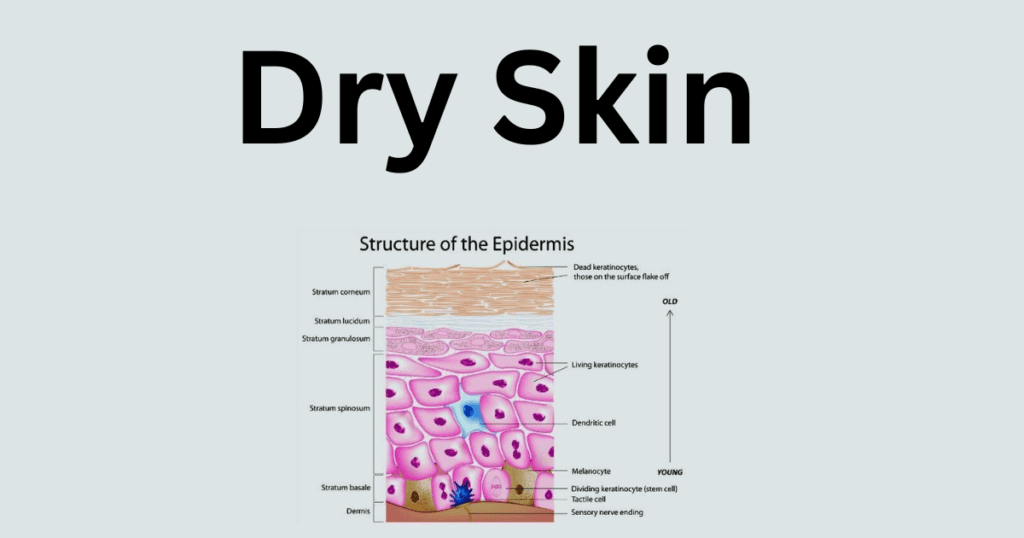
Characteristics:
- Can often be tight, rough, and flaky
- Dull color
- Fine lines with more attention
- Small, invisible pores
Care Tips:
Dry skin needs extra hydration. Choose products that are creamy, hydrating cleansers, rich moisturizers and contain ingredients like hyaluronic acid, glycerin and ceramide. Avoid hot water and harsh soaps, as these can strip away natural oils. Regular use of hydrating masks can also be beneficial( Skin Care Routine)
Oily Skin
Characteristics:
- A tendency to shine, especially in the T-zone (forehead, nose and chin).
- Enlarged pores
- Frequent breakouts and blackheads
- dark color
Care Tips:
For oily skin, it is important to control excess oil without stripping the skin. Use gel-based or foaming cleansers, oil-free moisturizers, and non-comedogenic products. Include salicylic acid or benzoyl peroxide to help manage breakouts, and use a clay mask to absorb excess oil.( Skin Care Routine)
Combination Skin
Characteristics:
- Both oily and dry areas, usually oily in the T-zone and dry or normal features on the cheeks
- Enlarged pores in the T-zone
- Breakouts in oily areas
Care Tips:
Combination skin needs a tailored approach. Use gentle cleansers suitable for all skin types. Apply light, oil-free moisturizers to the T-zone and rich creams to dry areas. Exfoliate regularly to keep pores clean and balance skin texture.( Skin Care Routine)
Sensitive Skin
Characteristics:
- Easy irritation, redness and risk of reactions
- Thin, delicate texture
- Experience frequent burning or itching sensations
- Visible capillaries or veins
Care Tips:
Sensitive skin needs soothing and calming products. Choose fragrance-free, hypoallergenic cleansers and moisturizers with ingredients like aloe vera, chamomile and green tea. Avoid products containing alcohol, harsh chemicals and physical exfoliants. Always patch test when trying new products.( Skin Care Routine)
Step-by-Step Guide to Building Your Routine
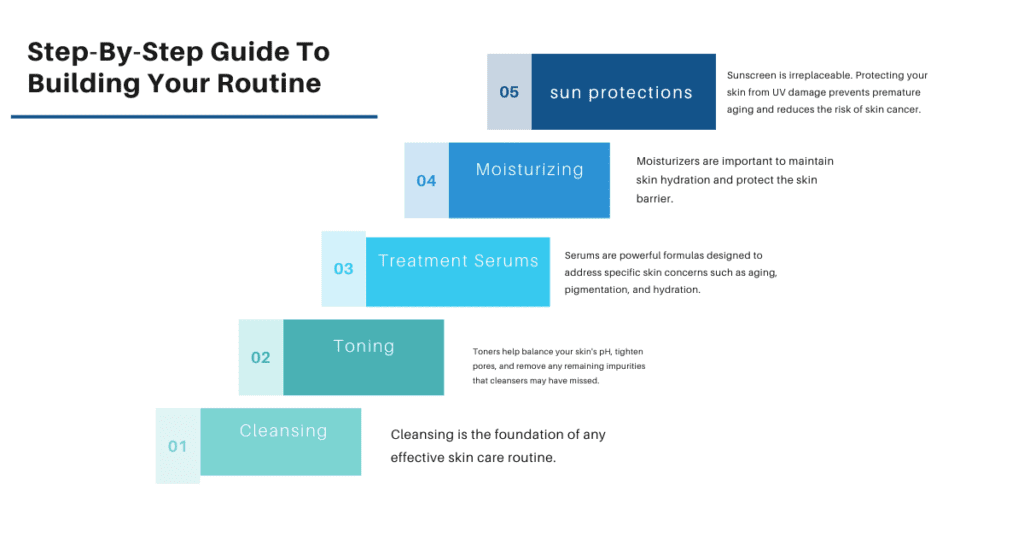
1. Cleansing
Morning and night: Cleansing is the foundation of any effective skin care routine. It removes dirt, oil and impurities that build up on( Skin Care Routine)
your skin day and night, ensuring your skin is clean and ready for the next skincare steps.
- Normal Skin: Use a gentle, pH-balanced cleanser to maintain your skin’s natural barrier. These cleansers effectively clean without stripping the skin of its natural oils.( Skin Care Routine)
- Dry Skin: Opt for a hydrating cleanser with ingredients like hyaluronic acid or glycerin. These ingredients help to lock in moisture, preventing your skin from becoming dry and flaky.( Skin Care Routine)
- Oily Skin: Choose a foaming or gel-based cleanser that can control excess sebum. These types of cleansers help to remove excess oil and reduce shine.
- Combination Skin: A balanced cleanser that doesn’t strip the skin is ideal. Look for products that can cleanse without overly drying out the skin or increasing oiliness.( Skin Care Routine)
- Sensitive Skin: Use a fragrance-free, soothing cleanser to prevent irritation. Ingredients like aloe vera and chamomile can help calm and soothe sensitive skin.( Skin Care Routine)
2. Toning
After cleansing: Toners help balance your skin’s pH, tighten pores, and remove any remaining impurities that cleansers may have missed.
- Normal Skin: Look for alcohol-free toners with hydrating ingredients. These help to refresh and balance the skin without causing dryness.( Skin Care Routine)
- Dry Skin: Choose toners with hydrating and soothing properties. Ingredients like rose water and glycerin can provide an extra layer of moisture.( Skin Care Routine)
- Oily Skin: Opt for toners with ingredients like salicylic acid or witch hazel. These can help control oil production and keep pores clear.( Skin Care Routine)
- Combination Skin: Use a toner that balances and hydrates without over-drying. This helps to maintain equilibrium between the oily and dry areas of your skin.( Skin Care Routine)
- Sensitive Skin: Gentle, alcohol-free toners with calming ingredients like chamomile are best. These prevent irritation and soothe the skin.( Skin Care Routine)
3. Treatment Serums
Target Specific Concerns: Serums are powerful formulas designed to address specific skin concerns such as aging, pigmentation, and hydration.
- Normal Skin: Use a general antioxidant serum like vitamin C to protect and brighten the skin. Antioxidants help to neutralize free radicals that can cause skin damage.( Skin Care Routine)
- Dry Skin: Hydrating serums with hyaluronic acid or peptides work well. These ingredients draw moisture into the skin, providing deep hydration.( Skin Care Routine)
- Oily Skin: Niacinamide or BHA serums can help control oil and minimize pores. They help to balance oil production and reduce the appearance of large pores.( Skin Care Routine)
- Combination Skin: A balancing serum with antioxidants and light hydration is ideal. This helps to address both oily and dry areas of the skin.( Skin Care Routine)
- Sensitive Skin: Calming serums with ingredients like niacinamide or allantoin. These help to soothe and reduce inflammation.( Skin Care Routine)
4. Moisturizing
Seal in hydration: Moisturizers are important to maintain skin hydration and protect the skin barrier.
- Normal Skin: A lightweight, non-comedogenic moisturizer suffices. These moisturizers hydrate without clogging pores.( Skin Care Routine)
- Dry Skin: Rich, emollient creams with ceramides and fatty acids. These ingredients help to restore the skin barrier and lock in moisture.( Skin Care Routine)
- Oily Skin: Gel-based, oil-free moisturizers are ideal. These provide hydration without adding excess oil.( Skin Care Routine)
- Combination Skin: A lightweight moisturizer that hydrates without clogging pores is best. This ensures that both dry and oily areas are adequately moisturized.( Skin Care Routine)
- Sensitive Skin: Fragrance-free, soothing moisturizers with ingredients like aloe vera. These help to prevent irritation and calm the skin.( Skin Care Routine)
5.sun protections
Daily: Sunscreen is irreplaceable. Protecting your skin from UV damage prevents premature aging and reduces the risk of skin cancer.
- Normal Skin: A broad-spectrum SPF 30 or higher is sufficient to protect against both UVA and UVB rays.( Skin Care Routine)
- Dry Skin: Hydrating sunscreens with additional moisturizing properties help to keep the skin hydrated while protecting it.( Skin Care Routine)
- Oily Skin: Matte-finish, oil-free sunscreens help to control shine and prevent breakouts.( Skin Care Routine)
- Combination Skin: Lightweight, non-greasy sunscreens provide effective protection without causing breakouts or dryness.( Skin Care Routine)
- Sensitive Skin: Mineral-based sunscreens with zinc oxide or titanium dioxide are less likely to cause irritation.( Skin Care Routine)
6. Night Care Routine
Boost repair: Night time is when your skin repairs and regenerates. Adjust your routine to focus on deep healing and hydration.
- Normal Skin: Continue with your usual routine and add a night cream to support overnight skin repair.( Skin Care Routine)
- Dry Skin: Use a richer night cream or sleeping mask to provide intense hydration while you sleep.( Skin Care Routine)
- Oily Skin: Lightweight, hydrating night gels help to provide moisture without clogging pores.( Skin Care Routine)
- Combination Skin: Balance hydration with lightweight formulas that cater to both dry and oily areas.( Skin Care Routine)
- Sensitive Skin: Gentle, calming products to aid overnight repair and reduce any inflammation or irritation.( Skin Care Routine)
7. Weekly Treatments
Exfoliation and mask: Weekly treatments can enhance your routine by providing deep cleansing and targeted treatments.
- Exfoliation: Use once or twice a week to remove dead skin cells and promote cell turnover.
- Normal/Dry Skin: Gentle chemical exfoliants with AHAs (alpha hydroxy acids) are ideal. They help to smooth the skin and improve texture without causing dryness.( Skin Care Routine)
- Oily/Combination Skin: BHA (beta hydroxy acid) exfoliants help to control oil and prevent breakouts by penetrating deep into the pores.( Skin Care Routine)
- Sensitive Skin: Gentle enzymatic exfoliants are less likely to cause irritation and can provide mild exfoliation.( Skin Care Routine)
- Normal/Dry Skin: Gentle chemical exfoliants with AHAs (alpha hydroxy acids) are ideal. They help to smooth the skin and improve texture without causing dryness.( Skin Care Routine)
- Masks: Tailor your mask to your skin’s needs for additional benefits.
- Hydrating Masks: For dry and sensitive skin, these masks provide intense moisture and soothe irritation.( Skin Care Routine)
- Clay Masks: For oily and combination skin, clay masks help to control excess oil and reduce the appearance of pores.( Skin Care Routine)
- Brightening Masks: For all skin types, these masks help to enhance radiance and even out skin tone.( Skin Care Routine)
- Hydrating Masks: For dry and sensitive skin, these masks provide intense moisture and soothe irritation.( Skin Care Routine)
How to Determine Your Skin Type
Understanding your skin type is key to creating an effective skincare routine for your specific needs. Recognizing whether your skin is oily, dry, normal, combination, or sensitive can help you choose the right products and treatments. Here’s a detailed guide to help you determine your skin type.
Step 1: Cleanse Your Face
Start by washing your face with a gentle, non-stripping cleanser to remove makeup, dirt, and excess oil. This ensures that your skin is clean and free from any external factors that can affect its natural state. Use lukewarm water to clean, as hot water can strip the skin of its natural oils, and cold water may not remove all impurities.
Step 2: Pat Dry
Gently dry your face with a soft, clean towel. Avoid rubbing your skin, as this can cause irritation. Do not apply any additional products such as moisturizers, serums, or toners at this point. Your goal is to observe your skin in its natural state.
Step 3: Wait and Observe
Allow your skin to rest for about an hour without applying any products. This waiting period allows your skin to return to its natural state, providing a more accurate assessment of your skin type. During this time, avoid touching your face to avoid transferring oil and bacteria.
Step 4: Examine Your Skin
After an hour, stand in front of a mirror in natural light and see how your skin looks and feels. Pay attention to different areas of your face including your forehead, nose, chin, and cheeks. Consider factors such as texture, shine, and any areas of dryness or oiliness.
Step 5: Conduct tissue testing
Take a clean tissue or blotting paper and gently dab it on different parts of your face: your forehead, nose, chin and cheeks. This test helps identify areas of oiliness or dryness.
Understanding your skin type is the first step towards a successful skincare routine. Tailoring your skin care products and diet to your specific needs will help you achieve a healthy, glowing complexion. By knowing your skin’s characteristics and how to best care for it, you can make informed choices that enhance your skin’s natural beauty.
Health care QNA
Q: What is preventive health care?
A: Preventive healthcare focuses on maintaining health and preventing diseases before they occur. These include measures such as vaccinations, screenings, and lifestyle modifications to prevent the onset of disease. Regular check-ups, healthy eating, exercise, and giving up harmful habits like smoking are key elements of preventive health care.
Q: How often should I have a regular physical exam?
A: The frequency of routine physical exams can vary based on age, health status, and risk factors. In general, adults should have a physical exam annually or every two to three years if they are younger and in good health. Older adults or those with chronic conditions may need more frequent visits. It is best to consult your healthcare provider for individualized advice.
Q: What are the benefits of a balanced diet?
A: A balanced diet provides the body with the nutrients it needs to function properly. It can help maintain a healthy weight, reduce the risk of chronic diseases such as heart disease, diabetes and cancer, and promote overall well-being. A balanced diet usually includes a variety of fruits, vegetables, whole grains, lean protein, and healthy fats.
Q: How much exercise is recommended to maintain good health?
A: The American Heart Association recommends at least 150 minutes of moderate-intensity aerobic activity or 75 minutes of vigorous-intensity activity per week, including muscle-strengthening activities two or more days per week. This can include activities such as brisk walking, running, swimming or cycling.
Q: What are the common symptoms of stress and how can it be managed?
A: Common symptoms of stress include headaches, fatigue, irritability, anxiety and difficulty sleeping. Stress can be managed through a variety of techniques, including regular physical activity, relaxation exercises (such as deep breathing or meditation), maintaining a healthy work-life balance, and seeking support from friends, family, or a mental health professional.
Q: What are the signs I should see a doctor right away?
A: You should see a doctor immediately if you have chest pain, shortness of breath, sudden weakness or swelling, severe headache, high fever, persistent vomiting or diarrhea, or other unusual or related symptoms. It is always better to err on the side of caution and seek medical advice if you are unsure.
Q: How can I improve my sleep quality?
A: Sleep quality can be improved by establishing a regular sleep schedule, scheduling a comfortable bedtime, keeping the sleep environment comfortable and free of distractions, limiting caffeine and heavy foods before bed, and avoiding screens (phones, tablets, TV). At least one hour before bed.
Q: What are the benefits of regular medical check-ups?
A: Regular medical check-ups can help detect potential health issues early, before they become more serious. They provide an opportunity to update vaccinations, discuss any health concerns, and receive personalized advice on maintaining a healthy lifestyle. Regular check-ups can lead to better management of chronic conditions and overall improved health outcomes.
skin care QNA
Q: What is the importance of a daily skincare routine?
A: A daily skincare routine is essential for maintaining healthy, vibrant skin. It helps to cleanse, hydrate, and protect the skin from environmental damage and aging. Consistent skincare can improve skin texture, tone, and overall appearance, as well as address specific skin concerns like acne, dryness, or sensitivity.
Q: How often should I exfoliate my skin?
A: Exfoliating 1-2 times a week is generally sufficient for most skin types. However, sensitive skin may require less frequent exfoliation, while oily skin might benefit from more frequent exfoliation. Over-exfoliation can lead to irritation and damage, so it’s important to adjust based on your skin’s response.
Q: What is the difference between physical and chemical exfoliation?
A: Physical exfoliation involves using scrubs or tools to manually remove dead skin cells, while chemical exfoliation uses acids (like AHA, BHA) to dissolve dead skin cells. Chemical exfoliants can be gentler and more effective for deeper exfoliation without causing micro-tears in the skin.
Q: How important is sunscreen in a skincare routine?
A: Sunscreen is crucial as it protects the skin from harmful UV rays, which can cause premature aging, sunburn, and increase the risk of skin cancer. Applying a broad-spectrum sunscreen with at least SPF 30 every day, even on cloudy days, is essential for maintaining healthy skin.

